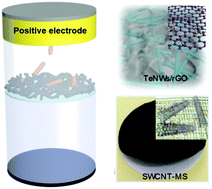Rechargeable ultrahigh-capacity tellurium–aluminum batteries†
Abstract
For exploring promising energy storage devices beyond lithium ion batteries, aluminum ion batteries (AIBs) are desirable cells with high energy-to-price ratios because of abundant natural resources, the higher energy density of aluminum and elimination of unexpected safety risks. Nevertheless, an ideal rechargeable AIB configuration with ultrahigh capacity is still fundamentally pursued. For fundamentally promoting the most promising chalcogen or chalcogenide-based AIB positive electrode materials, here rechargeable tellurium (Te) nanowire positive electrodes are demonstrated to construct novel tellurium–aluminum batteries. The cell configuration allows Te nanowires for delivering an ultrahigh discharge capacity ∼1026 mA h g−1 (with a specific current of 0.5 A g−1) along with an initial 1.4 V discharge voltage, competitive with the record-setting energy density of the documented AIBs. For essentially tackling the dramatic capacity loss in tellurium positive electrodes, the mechanism of impacting the rechargeable ability is linked to the production of soluble tellurium chloroaluminate compounds upon both chemical dissolution and electrochemical conversion processes. As a consequence, the cell configuration is proved to substantially suppress the unexpected shuttle effects induced by soluble tellurium chloroaluminate compounds via employing reduced graphene oxide to support the tellurium positive electrodes as well as utilizing functionalized carbon nanotube membranes to modify the separators. The implication of the results suggests a nice plateau for massively promoting the rechargeable ability of AIBs, advancing remarkable routes for achieving ultrahigh capacity and energy density.

- This article is part of the themed collection: 2019 Energy and Environmental Science HOT Articles


 Please wait while we load your content...
Please wait while we load your content...